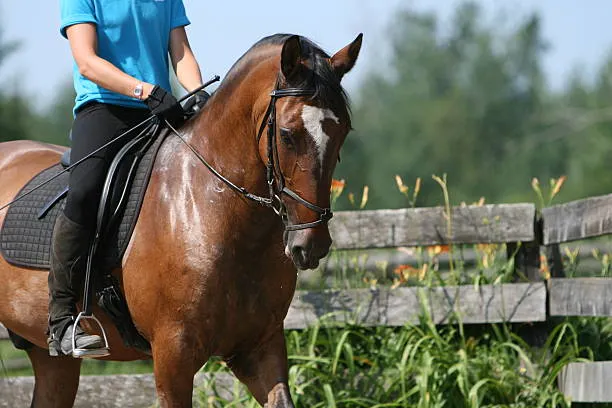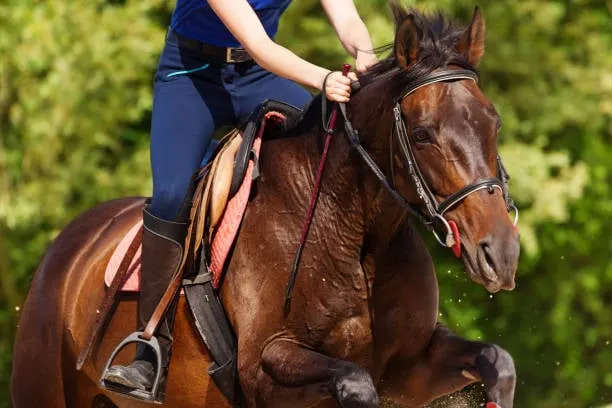The Use of a Whip or Crop in Horse Riding: Dressage, Show Jumping, and Cross-Country
When we horse ride, it is a sport that requires balance, communication, and a strong partnership between us and our horse. As a rider, having effective communication with our horse is key to achieving harmony and success. It should be used as an extension of our aids. While its purpose may vary across different disciplines, the use of a whip or crop is rooted in the goal of achieving better performance, precision and safety.
In this blog, we will explore the role of the whip or crop in three popular equestrian disciplines: dressage, show jumping, and cross-country. We will examine the types of whips or crops used in each discipline, how they are carried and applied and why they are important for both the horse and rider's performance.
The Role of the Whip or Crop in Horse Riding
A whip or crop is considered an artificial aid in horse riding, rather than a tool for punishment. It helps communicate subtle cues to the horse, guiding them to respond more accurately to us, the rider and our commands. The whip or crop is used to reinforce the our leg aids, encourage the horse to maintain rhythm and energy and improve the horse's performance during various movements and challenges.
The proper use of a whip or crop is essential to ensure the horse’s well-being and maintain a positive relationship between the horse and us, the rider. Improper or excessive use of a whip can lead to confusion, discomfort, fear, or injury, making it important for riders to understand the correct application of this tool. The type of whip or crop, the way it is carried, and the method of use can all vary depending on the discipline, each with its own set of rules and traditions.

1. Dressage: Precision, Elegance, and Subtlety
In dressage, the emphasis is on precision, elegance, and harmony. Dressage is often described as “horse ballet” due to the way in which the rider and horse perform intricate movements in perfect unison. The whip in dressage is used to aid communication between the rider and the horse, ensuring the horse responds promptly and correctly to subtle cues. Since dressage focuses on subtlety, the whip is a tool for reinforcing gentle aids rather than forcing the horse into action.
Type of Whip in Dressage
The whip used in dressage is called a “dressage whip”. It is longer and more flexible than the whips used in other disciplines. Typically, a dressage whip ranges from 1m - 1.2m in length. The whip has a slender, lightweight handle and is often equipped with a lash at the end. The lash is used for gentle taps and nudges, not for striking or punishment.
The length of the dressage whip allows the rider to reach the horse’s hindquarters without compromising their position or balance in the saddle. A key feature of the dressage whip is its flexibility, which allows for subtlety and finesse in use.
How and Why the Whip is Used in Dressage
In dressage, the whip is used to reinforce the rider's leg aids, encourage forward movement, and improve the horse's engagement. Its application should always be gentle and precise, with the goal of enhancing the communication between the rider and the horse. Here are a few common uses of the whip in dressage:
1. **Encouraging Forward Movement:**
A light tap of the whip on the horse’s hindquarters can encourage forward momentum, particularly when the horse is lagging behind or lacking energy. This ensures the horse maintains the desired pace and rhythm during movements.
2. **Refining Lateral Movements:**
In advanced dressage, lateral movements such as the leg yield, shoulder-in, and half-pass require precise control of the horse’s body. The whip can help to guide the horse's hindquarters and improve lateral flexion, aiding the rider in achieving these complex movements.
3. **Improving Transitions:**
The whip can also be used to help with transitions between gaits, such as from walk to trot, trot to canter or between different paces within the same gait. A light tap can serve as a cue to prompt the horse into the next gait, ensuring smooth and fluid transitions.
Dressage is all about finesse, and the whip should be held in the rider’s inside hand. It should never be used aggressively or excessively, but rather as a subtle extension of the rider's intention. It is a tool for guiding the horse without force.

2. Show Jumping: Precision, Speed, and Encouragement
Show jumping is an exciting and fast-paced discipline that requires precision, speed, and agility. Riders guide their horses over a series of jumps, striving to clear each obstacle without knocking down any poles. In show jumping, the crop is used to maintain the horse’s speed, improve its jumping technique, and ensure it stays focused on the course.
Type of Whip in Show Jumping
The whip used in show jumping is called a “jumping crop”. These whips are generally shorter and more rigid than dressage whips, with a typical length of 75cm. Jumping crops are designed to provide more direct communication with the horse, particularly when it comes to encouraging the horse to maintain its speed and jump effectively.
The jumping crop has a small, leather piece at the end. Some jumping crops also feature a flexible handle to allow for a secure and comfortable grip during fast-paced rides.
How and Why the Whip is Used in Show Jumping
In show jumping, the crop is used to provide additional encouragement and refine the horse’s technique during a round. The following are common ways in which the whip is applied:
1. **Maintaining Forward Momentum:**
The crop can be used to encourage the horse to maintain speed throughout the course, particularly when it starts to slow down or hesitate. A tap on the hindquarters can prompt the horse to pick up its pace, ensuring that the rider clears each jump with sufficient speed.
2. **Refining Jumping Technique:**
A light tap of the crop can encourage the horse to adjust its jumping form. For example, the whip may be used to prompt the horse to lift its front legs higher, improving the quality of the jump and reducing the risk of knocking poles.
3. **Boosting Confidence:**
In some cases, a rider may use the crop to help boost the horse's confidence, especially if the horse seems hesitant or distracted. The crop can provide a reassuring nudge that encourages the horse to continue with the course.
It is important that the crop in show jumping is used as an aid to encourage performance, not as a means of correction. It can be carried in either hand of the rider. The crop should be used sparingly and gently to avoid any negative associations.

3. Cross-Country: Endurance, Focus, and Encouragement
Cross-country is the most physically demanding of the three disciplines, requiring both the horse and rider to navigate a variety of natural and artificial obstacles, often over long distances and through varied terrain. The crop plays a critical role in keeping the horse motivated, maintaining rhythm, and ensuring the horse clears obstacles effectively during the course.
Type of Whip in Cross-Country
The crop used in cross-country is typically similar to the “show jumping crop” but may be slightly longer or sturdier to handle the demands of the discipline. Cross-country crops are 75cm in length with a flexible piece of leather for additional communication.
A cross-country crop is designed to withstand the rigors of rough terrain, and it is often made of durable materials such as synthetic fibers. The crop may also feature a thicker handle for better grip, which is important when riding through challenging terrain and obstacles.
How and Why the Whip is Used in Cross-Country
In cross-country, the whip is primarily used to encourage forward movement, maintain momentum, and help the horse navigate obstacles. Here are some key uses:
1. **Maintaining Forward Momentum:** Cross-country courses can be long, and horses may tire as they progress through the course. A tap of the crop on the hindquarters can help encourage the horse to keep moving forward and maintain its pace over long distances.
2. **Navigating Obstacles:** The crop can help guide the horse over challenging obstacles, such as water jumps, ditches, or logs. It can also help the horse focus on clearing jumps with the correct technique.
3. **Refining Speed and Timing:** Cross-country riders need to manage their speed throughout the course. The crop can be used to adjust the horse’s speed in specific areas, ensuring that the horse maintains the proper rhythm when approaching or clearing obstacles.
In cross-country, the whip can be carried in either hand of the rider, this allows the rider to focus on the control and direction of the horse while ensuring that the necessary hands are available for balance and positioning. As with the other disciplines, the crop should be used as a gentle aid rather than a tool for punishment.
Conclusion: The Whip or Crop as an Essential Communication Tool
The whip or crop is an essential aid in horseback riding, particularly in disciplines such as dressage, show jumping, and cross-country. Each discipline requires a different approach to whip use, depending on the specific demands of the sport. While the type of whip and the way it is used may differ, the overarching goal remains the same: to enhance the communication between the rider and the horse, helping to improve performance, encourage positive behavior, and ensure safety.
Whether used for encouraging forward movement, refining techniques, or maintaining rhythm, the whip or crop should always be applied with care and respect. When used correctly, it can become an invaluable tool in helping the horse and rider achieve their best performance. However, it is crucial to remember that the whip should never be used as a means of punishment, but rather as an aid to guide the horse through subtle, effective communication. By understanding the role and proper use of the whip, riders can develop a deeper connection with their horses, ensuring both success and harmony in the saddle.
